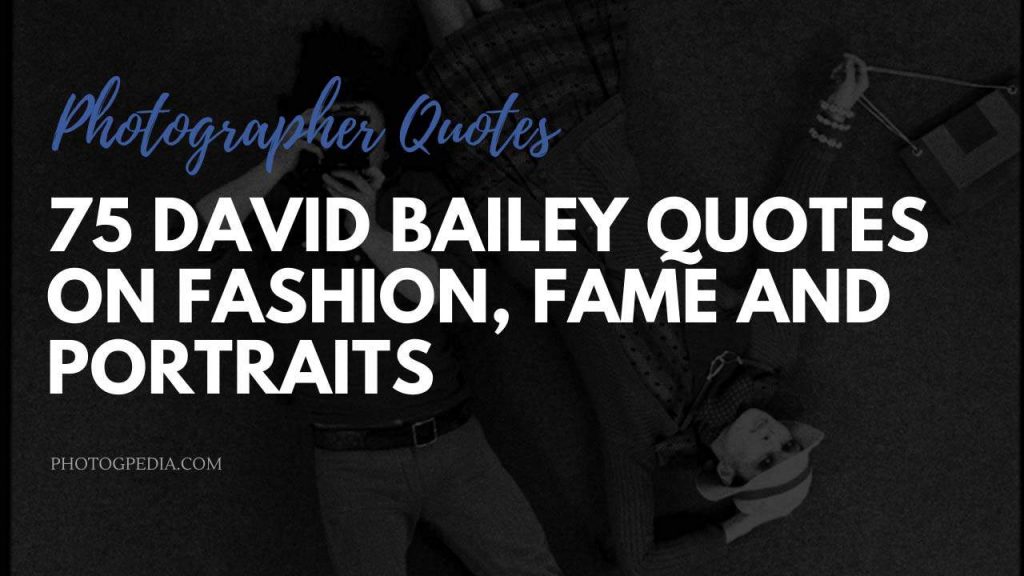Looking for the best David Bailey quotes? Then you’ve come to the right place. Below we’ve compiled a list of 75 quotes from the legendary photographer which are sure to inspire, motivate, and help take your photography to the next level.
David Bailey Quotes
It’s the moment that counts. It’s the only thing we’ve got in life really, and nothing captures it the way a stills camera does.
I know everything should be photographed. It helps me make sense of my existence.
It takes a lot of imagination to be a good photographer. You need less imagination to be a painter because you can invent things. But in photography everything is so ordinary; it takes a lot of looking before you learn to see the extraordinary.
The photographer who is closest to me, I think is the French photographer, I guess it’s the 1860s, Nadar. When I look at his pictures, I see my own pictures. He knew what I know or I know what he knew, whatever.
All pictures are unnatural. All pictures are sad because they’re about dead people. Paintings you don’t think of in a special time or with a specific event. With photos I always think I’m looking at something dead.
I don’t see the point of photographing trees or rocks because they’re there and anyone can photograph them if they’re prepared to hang around and wait for the light.
I’m an image-maker.
I’m not really interested in photography. I’m interested in what you can do with photography. If somebody says you gotta see a movie because the photography is so fantastic, I don’t want to see it, because I don’t wanna see a movie about photography, I want to see a movie about a story, and if I can learn something. I’m not going to learn anything from pretty photography. With my pictures, I just try and tell the story, boom immediately, without any window dressing, no palm trees.
Everyone will take one great picture, I’ve done better because I’ve taken two.
David Bailey Quotes
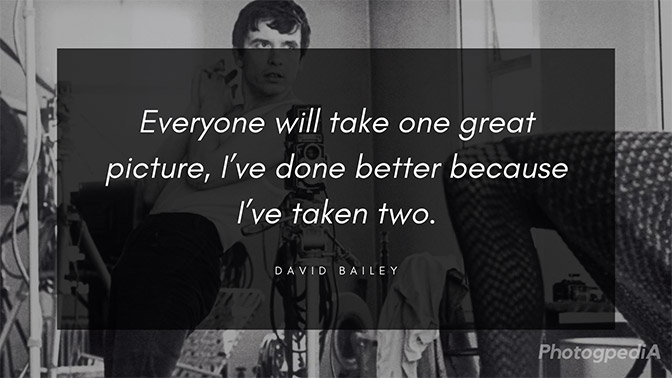
Bailey On His Photography Career
A positive attitude can really make dreams come true – it did for me.
Fortunately, I didn’t get educated because if I’d got educated I’d be an educated fool now.
I remember messing about with my mum’s Box Brownie. But everyone had a Brownie back then, they were like digital cameras are now. I could develop a picture by the time I was 12. I was dyslexic, you see – of course I didn’t know that until much later – and the only thing I was good at in school was art.
I just thought it was magic that you could stick a bit of paper in some coffee-type liquid and a picture comes out.
I was an assistant to a fashion photographer called John French. He weren’t a great fashion photographer but he was a kind and nice man. I guess the thing I got from him was the white background because he used the white background a lot. He helped me a lot. He got me a job doing pictures for teh Daily Express and Vogue saw the pictures and offered me a contract. I was only with him eleven months or so.
[On working as an apprentice to John French] I learnt very little there also! But he was shooting for Vogue and Harper’s and some fairly prestigious magazines with clients and models, gay people, straight people, working class, posh… it was an environment that taught me more about how to interact with people than about what sort of photograph I wanted to take.
If you try to get famous you won’t, but if you don’t care you probably will. You’ve got to stick to your guns, too, because once you back down you’re finished.
I had a terrible time with feminists in the Seventies. They hated me, those women. I think they hated everything.
I like change. There’s something Buddhist about it – continuous change is wonderful.
In ’73 I photographed the cannibals in New Guinea. They treated me okay but they didn’t make you feel relaxed… I managed to escape unscathed though, I’m pretty good at that.
I never tried to revolutionise photography; I just do what I do and keep my fingers crossed that people will like it.
When I stop working, I go out and start working again. Most people paint a picture, or whatever they do, and go home. For me, it has to be continuous.
The Swinging ’60s
I hate being so nostalgic about the Sixties.
The Sixties was a time of breaking down class barriers, although I think class still exists today in some areas.
Whenever I meet people from the sixties they keep going on about what a great time it was. It’s a great time now! I have always wanted to live in the present and never the past. Yesterday I shot Tom Ford. The week after next it’s Robert De Niro in New York. What makes you think I want to sit around with you and talk about the good old days when I have all that to look forward to?
The Sixties was great for the hundred or so of the ponces in London like me who were taking pictures or making movies or being Mick Jagger… but ask a coal miner from South Yorkshire what he thought of the Sixties and he’ll tell you just how cool it really was.
Bailey Quotes on Art and Painting
I don’t really like the term ‘artist.’ I’m not sure what it means. It’s a bit like ‘love.’
The only thing they can’t teach you at art school is art.
If something becomes old-fashioned, it was no good to start with. Think about it. Michelangelo is not old-fashioned.
It’s only a few nutcases who do art for themselves, like Van Gogh.
My first influence obviously was Picasso.
The cameras invented for surrealism. It’s the best for surrealism.
The first half of the 20th century belongs to Picasso and the second half is about photography.
Fashion Photography
There’s nothing wrong with being a fashion photographer, but it’s a bit limited.
Vogue called and offered me a contract. I turned them down. I mean, I had no real idea what Vogue meant in those days, all I knew is the money they offered me was less than what I was already earning. So I told them to sod off.
If someone offers you the chance to take pictures of pretty girls in frocks all day there are only so many times you can say no. But I always knew what I was there for at Vogue and those fashion magazines – it was to sell frocks. And I never wanted to be a fashion photographer. I was always more interested in people.
I never considered myself a fashion photographer. I’ve never really been interested in fashion. The reason I did fashion was that I liked what was in the frocks.
The reason I did fashion was it was the only way to get paid to do anything creative. You couldn’t support yourself as an ‘artist’ – I hate that word. The only way you could be ‘arty’ was as a fashion photographer, because it still had a certain amount of integrity involved.
It always amazes me when people ask you to do something and then tell you how to do it.
When I die I want to go to Vogue.
My fashion pictures are documents just as much as my boat people or my pictures for Band-Aid of Sudan.
The average fashion photographer is like a wedding photographer to me – they just do the same old thing.
Fashion often starts off beautiful and becomes ugly, whereas art starts off ugly sometimes and becomes beautiful.
Vogue weren’t keen on 35mm because they wanted everything on 5×4, so I shot everything on 35mm and didn’t tell them. I put the negatives in an enlarger and blew the negs up, so they never realized it was a small format camera. My argument was it wasn’t a loss of quality but a change of quality.
David Bailey on his famous New York photos for Vogue
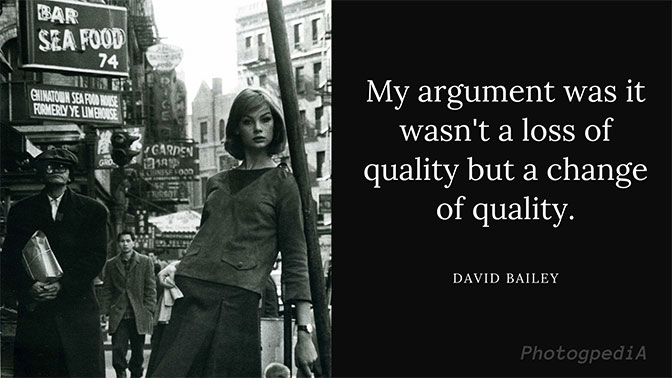
Working with Models
I sort of fall in love with them when I’m photographing them – men and women.
I didn’t try and do fashion pictures. I tried to do portraits of girls wearing dresses.
I never cared for fashion much, amusing little seams and witty little pleats: it was the girls I liked.
I have never met an ugly woman.
There’s planning, but you don’t know it. I like not knowing – or pretending I don’t know what I’m gonna do until it happens. It’s worked for me. Halfway through I thought, I better stick to this way then. It’s good.
I like people with their own beauty.
Jean Shrimpton and I used to do shoots all alone – just us, no hair or makeup or anything. Stick some things in the back of the f—ing Mini and go do it. We shot on the street.
I photographed women the way I saw them on the streets. People could identify with Jean because I didn’t make her look like a stuffed shop mannequin. Suddenly she was someone you could touch, or maybe even take to bed.
I’ve been used by women all my life, fortunately.
I always liked the same girls. I would work with the same girl for ten years. I like the idea of working with the same [girl]. It cuts out all the rubbish, because you can get to the point much quicker if you work with someone a lot.
Kate Moss is the best thing since Jean Shrimpton, really. She’s so beautiful without being beautiful, it’s amazing. You can’t understand it… I can’t undertand it. There’s nothing special about the Mona Lisa, it’s a painting, but it’s got something you can’t explain.
Bailey on Portraits
When I photograph people, as soon as they come through the door, I’m already photographing them. You watch the way they move, their personality, and which side of their face they prefer. All sorts of things. What kind of mood they’re in and it’s like a zen thing. If they’re in a bad mood you encourage the bad mood, because you get something from the picture. If they’re in a good mood, you encourage the good mood. That’s why I like my pictures, because you can’t really copy what I do because I don’t do anything. I just do it with dialogue really and talking to people.
You treat each person as an individual…You adapt to who you’re photographing. It’s their personality, not mine I want.
Most of the work that goes into a portrait is done before the subject even gets in front of the lens and starts trying to pose or pull silly faces. It’s almost a physical thing for me, whether it’s a man or a woman. It’s knackering sometimes! You talk to them first, flirt with them, piss them off… try and get to them so you can get past that shiny, polite veneer most of them walk about parading.
I wouldn’t photograph anybody if they only give you five minutes. I don’t care who it is. I don’t care if God phoned me up and said, “I want a picture, I’ve only got five minutes.” I’d say, “Well, work some of your magic and make it longer!” Even though I’m actually quicker than most and I usually get bored before they get bored.
I’m not looking for anything, I’m looking for that person. I’m looking for what they have. I know what I have. I know my limitations… I want to get these people to look like they have no limitations. It’s from them really. It’s like being a vampire, I wanna capture their personality.
In a way, portraits are the last photography that will ever be finished. You’ve got a connection between two people. Art photographers always have a young girl, I don’t know, 18 or something, with a flowery dress standing on flowery wallpaper, and it’s the same picture. She looks bored and lost. Well, I hope mine never look bored. They can look lost if they like, but not bored.
Bailey on Famous Sitters
Actors are the most difficult because you never know who you’re photographing. They could be Hamlet or Lassie.
Actors are hard to photograph because they never want to reveal who they are. You don’t know if you’re getting a character from a Chekhov play or a Polanski film. It depends what mood they’re in.
I spend a couple of hours talking to them and about 10 minutes taking the pictures. I don’t know why people f— about taking the pictures. You try and find a connection. Anything – gardening, ornithology. I always use pictures that they’re happy with – well, no I don’t. Because they’re not always the right judge, are they? They have to accept what I do. Otherwise, it’s not my picture. With editorial work, I send one picture.
Oliver Stone turned up at my studio shortly after and said, ‘Are you as quick as [Richard] Avedon, because I only have five minutes?’ He would hardly talk to me. So, I said, ‘All right then.’ He stood in front of the camera and – ‘click’ – I took one single frame and then walked away. He said, ‘What? I thought you were going to be quick,’ I turned to him and was like, ‘I’m done. That’s it. Off you go then!’ He ended up staying all f—ing day!
Rockers are the nicest people to photograph. They have no inhibitions.
Bailey on Simplicity and Style
I always go for simplicity.
I don’t know what I do. All I know is that when other people do white backgrounds, they look like passport pictures.
I think I like the white background because if I’ve got Jean Shrimpton or Kate Moss, why do I need a palm tree in the background. I think it’s much better if I reduce it all, so it goes to nothing, then you end up with the personality of the person. There’s no distraction.
A style is really dangrous. I mean you try to avoid it… it’s like being political. When someone says they’re not being political, they’re already political. So when I say, I have no style. I do but I don’t want it. My style is nothing. It’s my way of making everything minimal.
This sounds really prentious: making everything minimal, and just concentrating on the person, and getting rid of everything else, it’s just the person I want. That’s the only thing I want. I don’t want anything else, I don’t want their hands, I don’t want this silly thing that looks like they’re on a back of a book. It makes it harder for me. I just want… I want very sophisticated passport pictures, which are quite hard to do.
David Bailey Quotes
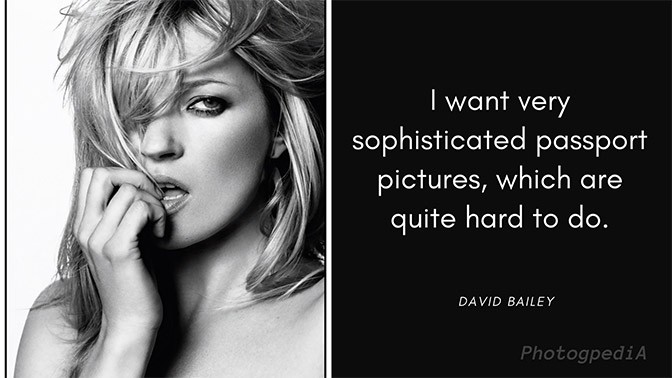
Quotes on Digital Photography and Post-Processing
They said digital would kill photography because everyone can do it but they said that about the box brownie in 1885 when it came out. It makes photography interesting because everyone thinks they can take a picture. There’s more people to make me look better.
Nothing wrong with retouching… nothing new about retouching either.
It’s changed a bit now with digital, because everybody thinks everyone’s cheating. It’s what Count Basie said, when they ask him what Jazz was, which is the same as saying what’s art, and Count Basie said, “It’s four beats to the bar and no cheating.” Which I try and make my pictures like that, “four beats to the bar and no cheating.”
David Bailey Quotes for Better Photography
I’ve always tried to do pictures that don’t date.
I always look at people and think how I would cast them.
Being trendy is dangerous. I’ve never been trendy, which is why I’ve never really fallen out of favour.
The best advice I ever got was that knowledge is power and to keep reading.
You have to kind of be invisible when you photograph children, so you use a longer lens.
It’s not about composition. It’s the way you feel about how your objects should relate to each other. I’ve got lots of African statues and things, and the cleaner arranges them like soldiers, which drives me mad. So I have to rearrange them, and I must drive her mad, because I’m doing anarchy and she’s doing military manoeuvres.
When I was on trips I used to put Polaroid’s in a container with sea water, sand and pebbles. I’d swirl it all around to get scratches. It’s this random element that I call ‘the drip’. It’s the drip which might splash onto the other side of the canvas when you’re working on a painting and make you think ‘that is good’, possibly leading you to explore other things. My whole life is spent in search of the drip; it can change everything.
Anybody can be a great photographer if they zoom in enough on what they love.
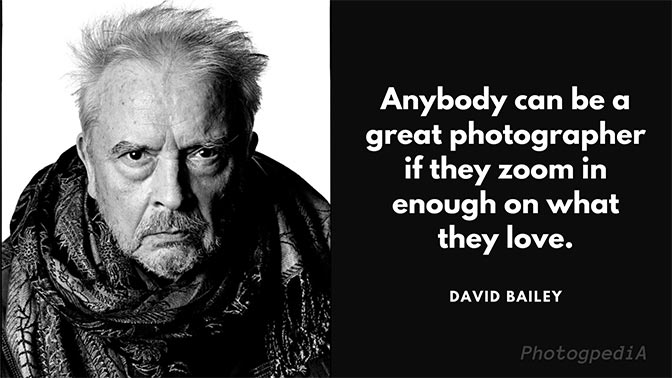
What’s your Favorite David Bailey Quote?
Have a favorite David Bailey quote from the list? Let us know in the comment section below.
Don’t forget to bookmark this page, or print it out, and refer to it next time you need some inspiration. Also, don’t forget to share it with others through the usual channels (social media, forums, websites, etc).
Looking for more words of wisdom from master photographers? Visit the quotes section of Photogpedia for more great photography quotes.
More Quote Articles:

